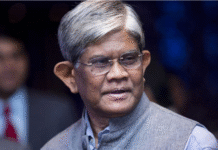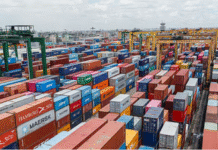Say Standard Chartered economists

Bangladesh might be one of only two ASEAN and South Asian economies to register positive growth in 2020 despite a global recession that is shaping up to be historic in scale, according to Standard Chartered Bank’s research team.
“The worst has passed us,” said Saurav Anand, an economist of Standard Chartered for South Asia.
The economy faced challenges between April and June,
Now, there are early signs of recovery in some pockets after the economy started opening up from June, he said at a webinar styled ‘Standard Chartered Global Research Briefing Media Engagement Session’ yesterday.
“Recent economic data have shown a good amount of improvement,” Anand added.
“From a GDP growth perspective, the second quarter of the year was probably the worst for all countries. The recovery is already there,” Lee added.
Bangladesh’s economy grew 5.24 per cent in the fiscal year that concluded on 30 June, much better than the grim forecasts made by the multilateral lenders.
The Washington-based multilateral lenders — the World Bank and the International Monetary Fund — had forecasted that the economy would grow between 1.6 per cent and 3.8 per cent in fiscal 2019-20 for the pandemic-whiplash, while the Asian Development Bank said the Bangladesh economy would expand at 4.5 per cent.
Standard Chartered forecasted that Bangladesh’s economy would expand 5.6 per cent in fiscal 2020-21.
The slower growth momentum is expected to continue in the current fiscal year although the government is expecting a V-shaped recovery and
But the government is aiming for an 8.2 per cent GDP growth, banking on a V-shaped recovery, which entails a leap back to the previous peak after a sharp decline.
Lower growth will partly be driven by slowdowns in key trading partners, with the Eurozone, the US and the Middle East likely to contract sharply in fiscals 2019-20 and 2020-21, the bank said in a press release.
Economic activities plummeted quite a bit from the end of March to the end of May, Anand said. Exports and imports dropped significantly.
Remittances were up in June and July. Exports in July also went up.
“So, the decent amount of data that is coming out is showing that some rate of recovery is underway.”
There is a clear room in terms of fiscal and monetary policy space to boost growth.
According to Anand, the fiscal deficit would widen to 7.5 per cent if the growth disappoints.
There is a room for a rate cut to happen in the monetary policy, he said.
The central bank has already cut 125 basis points. The cash reserve ratio has also been cut to inject liquidity.
Bangladesh is likely to maintain a robust foreign currency reserve of close to $40 billion in the current fiscal year, providing a good buffer to the economy, Anand said.
The low debt-GDP ratio provides much room to the government to come up with further stimulus measures, he added.
The world has been in the midst of an unprecedented crisis, Lee said. At the same time, the governments have come up with unprecedented measures, both monetary and fiscal.
Compared to the global financial crisis, the banking system is in a much better situation. But companies would not borrow much to invest if their demand is subdued, he said.
There’s some recurrence of infections in various parts of the world, including in the US, the UK, Australia, New Zealand and Japan. But the governments are now in a much better position to respond and their health care capacities have expanded.
“The crisis has been unprecedented. But the truth is the governments’ responses in terms if monetary and fiscal steps have also been unprecedented. The support is significant and this is a positive aspect.”
According to Lee, bringing infections under control should be the utmost priority for any country.
As economies reopen, businesses and consumers need to adhere to standard operating procedures to ensure the sustainability of the recovery and minimise the risk of recurrence of infections.
“I think you don’t want an economic recovery that starts and stops and starts and stops, which makes it very difficult for businesses to plan for investment,” Lee added.
The exchange rate of the taka against the US dollar will remain stable for the rest of the year, said Divya Devesh, head of ASA FX Research at Standard Chartered.
“The external balance situation is quite supportive. The balance of payment is likely to be in surplus. The record foreign currency reserve suggests that the central bank has ample dollars to tide over any difficulties.”
On most metrics, Bangladesh scores very highly on reserves adequacy, Devesh added.
Still, there is a lot the government can do to amp up economic activities, particularly when it comes to ease of doing business.
The government has taken steps to facilitate doing business in the last three to four years and there is a need to expedite the implementation in the current situation, Anand said.
“Most of the challenges facing the economy are structural and are well-known. This is a domestic situation that can be handled.”
Bangladesh has to ensure less reliance on key economic partners and the economy is more resilient to withstand any future shocks.
“As the government gains more experience in handling the Covid-19 situation, there would be more confidence domestically to come out, consume and invest,” Anand added.
There are lots of challenges that are not in Bangladesh’s hands, said Muhit Rahman, head of financial markets of Standard Chartered Bangladesh.
The country is exposed to Europe and the US for exports.
As the overall external debt to GDP ratio is very low, the country is in a good position to absorb a V-shaped recovery and Bangladesh has a significant chance of tapping into international liquidity.
“This is a unique opportunity. I don’t think any other country would be in such a position. We are very optimistic about the recovery of Bangladesh,” Rahman added.
Earlier, the economists spoke at the 2020 Bangladesh session of the Bank’s Global Research Briefing series. More than 300 clients joined via video-conferencing.
Speaking at the event, Shibli Rubayat-Ul-Islam, chairman of the Bangladesh Securities and Exchange Commission, said: “We expect Bangladesh to have a V-shaped recovery post-COVID-19 reaching back to more than 8 per cent GDP growth trajectory within 2021.”
Bangladesh entered these turbulent times on a much stronger footing compared to many of its peers, due to low external debt, low overall public debt and comfortable debt service capability because of its healthy foreign exchange reserve, said Naser Ezaz Bijoy, chief executive officer of Standard Chartered Bangladesh.
“By working together across the board, we can leverage our solid economic fundamentals and the innate resilience of our communities to quickly regain lost ground and achieve all our ambitions and aspirations for our nation.
“While global economic recovery seems gradual and there will be uncertainties, we need to have robust financial risk management practices and adopt a culture of hedging against adverse movements in interest, foreign currency and commodity prices.”
This will allow businesses to reduce uncertainties around volatility, he added.
Bitopi Das Chowdhury, head of corporate affairs, brand & marketing at Standard Chartered Bangladesh, also spoke.









